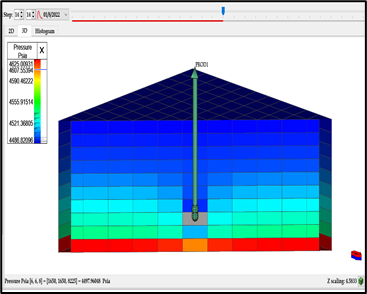Prediction of Gas Coning in Hydrocarbon Reservoir using tNavigator
DOI:
https://doi.org/10.37934/progee.18.1.122Keywords:
Gas Coning, Breakthrough time, tNavigator simulation, Critical rate correlation, Gas-Oil ratio, Vertical wellAbstract
Several approaches for avoiding gas breakthrough due to coning phenomena have been proposed. These methods include maintaining oil production rates below critical rates, inserting crosslinking gels near the well to create a gas-blocking area, and making perforation as far away from the initial gas-oil contact (GOC) as possible, often considered uneconomically solutions and not sufficient way to deal with the problem. Furthermore, this is a major source of concern in terms of the additional costs of separation procedures and equipment availability. Coning couldn’t possibly be totally eliminated, but it can be minimized by defining the breakthrough time and understanding the characteristics that have a significant impact on breakthrough time and how effectively may be manipulated to delay it. A mathematical and numerical approach was used in this research for the purpose of gas breakthrough time investigation and monitoring the gas-oil ratio (GOR). tNavigator embedded flow equation was used as a novel 3D compositional simulation principle in the software to predict the time of gas flow from grid cell to another reaching the perforation interval, for the purpose of utilizing the sensitivity analysis of certain parameters which had sufficient impact on GOR value and breakthrough time (tBt). Results show that the Oil column is the most effective parameter in the sensitivity analysis and the one factor to focus on while producing from gas cap reservoirs.
References
D.G. Hatzignatiou, and F. Mohamed, Water and gas coning in horizontal and vertical wells, (1994). https://doi.org/10.2118/871-PA.
I.A. Isemin, Numerical Simulation of Gas Coning of a Single Well Radial in a Naturally Fractured Reservoir, (2012).
O.A. Olabode, E. Etim, E.E. Okoro, T. Ogunkunle, V.D. Abraham, Predicting post breakthrough performance of water and gas coning, Int. J. Mech. Eng. Technol. 10(02) (2019) 255-272.
T. Ahmed, Reservoir engineering handbook, Gulf professional publishing, (2018). https://doi.org/10.1016/C2016-0-04718-6.
S.I. Onwukwe, B. Obah, G.A. Chukwu, A model approach of controlling coning in oil rim reservoirs, In Nigeria Annual International Conference and Exhibition, Society of Petroleum Engineers, (2012). https://doi.org/10.37591/jopet.v2i1-3.2199.
H.I. Meyer, A. O. Garder, Mechanics of two immiscible fluids in porous media, (1954). https://doi.org/10.1063/1.1721576.
G.L. Chierici, G.M. Ciucci, G. Pizzi, A systematic study of gas and water coning by potentiometric models, (1964). https://doi.org/10.2118/871-PA.
I. Chaperon, Theoretical study of coning toward horizontal and vertical wells in anisotropic formations: subcritical and critical rates, (1986). https://doi.org/10.2118/15377-MS.
L.A. Høyland, P. Papatzacos, S.M. Skjaeveland, Critical rate for water coning: correlation and analytical solution, (1989). https://doi.org/10.2118/15855-PA.

Downloads
Published
How to Cite
Issue
Section
License
Copyright (c) 2022 Progress in Energy and Environment

This work is licensed under a Creative Commons Attribution-NonCommercial 4.0 International License.











